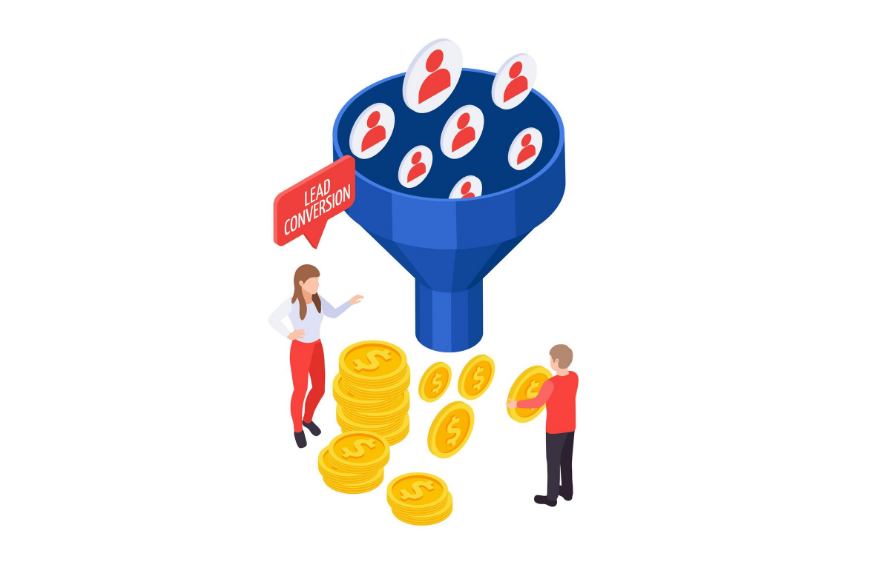Table of Contents
- Introduction to B2B Lead Generation
- Understanding Your Target Audience
- Utilizing High-Quality Content Marketing
- Leveraging Social Media for Lead Generation
- Implementing Marketing Automation Tools
- Optimizing Your Sales Funnel
- Networking and Partnerships: Building Relationships for Growth
- Utilizing Data Analytics for Better Decision Making
- Conclusion and Future Trends in B2B Lead Generation
Introduction to B2B Lead Generation
Business-to-Business (B2B) lead generation is a critical process through which organizations identify and attract potential customers interested in their products or services. This essential practice facilitates the establishment of long-term relationships and drives revenue. In the contemporary business landscape, effective lead generation strategies are more important than ever, given the competitive nature of the marketplace. As companies strive for growth, understanding and mastering lead generation techniques can significantly impact their success.
Traditional methods of lead generation often include tactics like cold calling, email outreach, and attending industry events. While these approaches can yield results, they may not always be the most cost-effective means of reaching potential clients. Recent studies suggest that about 61% of marketers report generating leads through content marketing, highlighting a shift towards more modern and innovative approaches. The rise of digital marketing has shifted the landscape, fostering new channels such as social media, SEO, and targeted advertising, allowing businesses to capture high-quality leads more efficiently.
Despite numerous strategies available, scaling B2B lead generation while keeping costs low presents distinct challenges. Businesses frequently encounter difficulties in maintaining consistent lead quality, adapting to changing customer preferences, and optimizing marketing budgets. Additionally, competition for attention in cluttered digital spaces can impede efforts, making it harder to engage potential clients effectively. As such, organizations must evolve their lead generation strategies to not only attract a larger volume of leads but also ensure that these leads are well-targeted and aligned with their business objectives.
In conclusion, understanding B2B lead generation’s significance, along with the challenges and differing methodologies, is paramount for businesses that aspire to scale sustainably without incurring excessive costs. The implementation of efficient, data-driven strategies will play a pivotal role in achieving this goal.
Understanding Your Target Audience
In the realm of B2B lead generation, comprehending your target audience is paramount to achieving success without incurring additional costs. A well-defined understanding of potential customers allows businesses to streamline their marketing efforts and enhance engagement. The first step in this process involves identifying and profiling your target customers. By gathering data on demographics, industries, and business sizes, organizations can segment their audience effectively, ensuring that marketing strategies are directed towards the right individuals.
Utilizing buyer personas is an essential technique in appreciating the needs and preferences of your audience. A buyer persona is a semi-fictional representation of your ideal customer, based on market research and real data. By creating comprehensive profiles that detail your target audience’s goals, challenges, and decision-making processes, businesses can tailor their content and messaging to resonate more effectively with potential leads. This targeted approach not only improves the likelihood of engagement but also reduces wasted resources spent on ineffective strategies.
In addition to creating buyer personas, it is vital to recognize customer pain points that drive their purchasing decisions. Understanding these challenges enables businesses to position their solutions as the optimal answer. Conducting effective market research through surveys, interviews, and social media analysis can yield valuable insights into what potential customers truly value. Utilizing tools such as Google Analytics or CRM software can further enhance understanding by tracking customer behaviors and interactions. Through diligent analysis and integration of these insights, businesses can craft well-informed marketing strategies that align closely with their audience’s needs.
Utilizing High-Quality Content Marketing
In the realm of B2B lead generation, high-quality content marketing serves as a powerful strategy for attracting and nurturing leads without incurring substantial costs. Creating valuable content not only positions your brand as an industry authority but also engages potential clients at various stages of their buyer’s journey. The content you produce, be it blog posts, e-books, webinars, or case studies, should aim to address the needs and pain points of your target audience.
Blogs, for instance, can provide insightful information on industry trends and best practices, helping to establish trust and credibility. E-books serve as comprehensive guides that delve deeper into specific topics, providing an opportunity to collect contact information from interested readers in exchange for valuable resources. Webinars create interactive platforms for engaging audiences, allowing for real-time discussions and demonstration of expertise. Case studies highlight successful outcomes for existing clients, providing social proof and encouraging potential leads to envision similar success through your services.
To maximize the effectiveness of your content marketing efforts, it is crucial to implement best practices for content distribution and search engine optimization (SEO). This entails optimizing your content with relevant keywords that resonate with your audience, ensuring that it ranks well in search engine results. Furthermore, distributing your content across multiple channels, such as social media, email newsletters, and industry-specific forums, will increase its visibility and reach. Ensuring alignment between your content and the buyer’s journey is vital; this means tailoring content to address the specific questions and concerns that potential clients may have at each stage, nurturing them towards a conversion effectively.
By integrating these strategies into your B2B lead generation efforts, you can attract high-quality leads organically, thereby scaling your initiatives without increasing costs.

Leveraging Social Media for Lead Generation
In the evolving landscape of B2B lead generation, social media platforms have emerged as pivotal channels for attracting potential clients. To effectively utilize social media for lead generation, it is essential to select the right platforms according to the demographics and preferences of your target audience. For instance, LinkedIn is particularly beneficial for B2B marketers, as professionals in various industries are active on this platform, facilitating meaningful networking opportunities and connections.
Engaging with prospects requires a strategic approach. Sharing insightful content, industry updates, and company news through posts can pique the interest of potential leads. Social media advertising further amplifies outreach efforts; targeted ads on platforms like Facebook and LinkedIn allow businesses to reach specific segments of their audience based on factors such as job title, industry, and interests. Such precision can lead to higher conversion rates and ultimately foster relationships with quality leads.
Utilizing analytics is crucial for refining messaging and optimizing social media strategies. Monitoring engagement metrics, such as likes, shares, and comments, provides insights into what resonates with your audience. Additionally, examining conversion rates from specific campaigns helps identify which strategies effectively drive leads. Regularly assessing this data enables businesses to adapt their approach, ensuring that messaging aligns with audience preferences and industry trends.
Moreover, building a community around your brand on social media can significantly enhance lead generation efforts. Encouraging discussions, participating in relevant groups, and responding to inquiries fosters relationships and establishes trust. This sense of community not only aids in immediate lead generation but also contributes to long-term brand loyalty and referrals, which are invaluable for sustained growth. By effectively leveraging social media in these ways, businesses can drive lead generation efforts without incurring additional costs.
Implementing Marketing Automation Tools
Marketing automation plays a pivotal role in enhancing lead generation efforts for B2B organizations, particularly as they aim to scale their operations without incurring additional costs. By automating repetitive tasks, companies can focus their resources on strategy and innovation rather than mundane processes. These tools streamline lead nurturing, ensuring timely and relevant communication with potential clients, which is essential for conversion. Furthermore, automation helps in personalizing interactions; this personalized communication can significantly increase engagement rates and foster stronger relationships with leads.
Several marketing automation tools are available on the market today, each offering a unique set of features tailored to different business needs. For instance, platforms like HubSpot and Marketo provide extensive lead management capabilities, allowing businesses to track interactions and score leads based on their engagement. These insights enable marketing teams to prioritize outreach efforts effectively. Additionally, tools such as Mailchimp and ActiveCampaign optimize email campaigns, allowing users to segment their lists and target specific demographics with custom messages. This level of personalization enhances the likelihood of conversion while keeping costs manageable.
To successfully integrate these automation tools into existing marketing strategies, businesses should start with a clear understanding of their specific goals and objectives. It is essential to evaluate the current lead generation processes and identify areas where automation can provide relief or improvement. Training staff on the selected tools ensures that teams can leverage the technology effectively, maximizing their potential. Ultimately, the right marketing automation tools can empower B2B organizations to scale their lead generation efforts and enhance overall efficiency, proving that it is indeed possible to grow without significantly increasing expenditures.
Optimizing Your Sales Funnel
To effectively scale B2B lead generation without increasing costs, optimizing your sales funnel is essential. A streamlined sales funnel not only enhances the transition from lead generation to customer acquisition but also ensures that resources are utilized efficiently. The first step in this optimization process is identifying potential bottlenecks within the funnel. Bottlenecks can often occur at various stages, including lead qualification, follow-ups, or during the final sales meeting. Regularly analyzing each stage of the funnel can provide valuable insights into where leads may be dropping off, allowing for targeted interventions.
Improving conversion rates is critical to maximizing the effectiveness of your sales funnel. This can be achieved through several strategies. First, refining the lead qualification process helps in focusing efforts on high-quality leads while avoiding wasted resources on prospects that are unlikely to convert. Implementing robust criteria for lead scoring can assist sales teams in identifying the most promising leads. Additionally, ensuring personalized communication tailored to the needs and pain points of the leads can significantly enhance engagement and drive conversions.
Another crucial aspect of sales funnel optimization is the implementation of effective follow-up strategies. Consistent and timely follow-ups can keep potential customers engaged and demonstrate the value of your offerings. Utilizing automated email sequences or customer relationship management (CRM) systems can help in managing follow-ups without overwhelming the sales team. Data analysis plays a vital role in refining these efforts. Regularly reviewing performance metrics such as conversion rates, average deal size, and sales cycle length provides a clearer picture of the sales funnel’s health and areas for improvement.
Continuous improvement is fundamental for ongoing success. By analyzing the data garnered from each stage of the sales funnel and applying iterative changes, businesses can effectively enhance their lead generation and conversion processes. Over time, this will lead to a more efficient and effective sales funnel, ultimately reducing costs and fostering higher sales growth.
Networking and Partnerships: Building Relationships for Growth
Networking and forming strategic partnerships are pivotal in enhancing B2B lead generation efforts without incurring additional costs. The world of business thrives on relationships, and by cultivating these connections, organizations can unlock new avenues for growth. One effective strategy is to attend industry events, such as conferences, trade shows, and seminars. These venues provide a platform to connect with potential clients, industry leaders, and like-minded professionals, fostering an environment conducive to sharing ideas and exploring collaborative opportunities. Engaging actively in discussions and exchanging business cards at these events can result in valuable partnerships that enrich the lead generation process.
Another method to consider is joining professional organizations. Many industries have dedicated associations that offer networking opportunities, access to resources, and training sessions. Membership in these organizations not only enhances credibility but also expands an organization’s network. Participating in workshops, webinars, and forums allows businesses to position themselves as thought leaders while building relationships that can lead to referrals. Such pertinence in a professional landscape builds trust and reliability, essential factors in generating leads effectively.
Leverage the power of online communities as well. Digital platforms such as LinkedIn, industry-specific forums, and social media groups facilitate networking from anywhere. By contributing valuable insights and engaging in meaningful conversations, businesses can cultivate a receptive audience and establish themselves as industry authorities. Moreover, collaborating with other businesses through co-marketing initiatives can extend reach and generate leads at a fraction of traditional marketing costs. Forming alliances to share resources and marketing efforts multiplicatively enhances visibility while minimizing expenses. Thus, strategic networking can be a cornerstone in B2B lead generation, enabling organizations to thrive in a competitive landscape without escalating costs.

Utilizing Data Analytics for Better Decision Making
In the evolving landscape of B2B lead generation, data analytics has emerged as a cornerstone for enhancing decision-making processes. By leveraging data analytics, organizations can gain a clearer understanding of their lead generation performance and refine their strategies accordingly. Key metrics such as conversion rates, lead source effectiveness, and engagement levels play a vital role in assessing the efficiency of lead generation initiatives. Monitoring these metrics allows businesses to identify patterns, understand what drives success, and discover areas that require improvement.
To harness the power of data analytics, organizations must implement robust analytic tools that facilitate data collection and interpretation. These tools enable the tracking of various lead generation tactics, from email marketing campaigns to social media outreach. By analyzing this data, businesses can measure how each channel contributes to overall lead generation efforts. Furthermore, utilizing techniques such as A/B testing can help pinpoint which messaging or creative elements resonate best with potential clients, leading to more tailored and effective campaigns.
Insights gleaned from meticulous data analysis should be actionable, empowering businesses to adjust their lead generation strategies dynamically. For instance, if data reveals that a particular lead source yields a substantially higher conversion rate, organizations might allocate more resources to that channel. Conversely, if certain efforts are underperforming, leaders can pivot quickly, reallocating resources to more promising initiatives. This data-driven approach not only enhances operational efficiency but also optimizes return on investment (ROI) by ensuring that marketing budgets are spent on the channels that deliver the best results.
Ultimately, incorporating data analytics into B2B lead generation allows businesses to make informed decisions that drive growth while avoiding unnecessary costs. By becoming proficient in data analysis, companies can harness the insights needed to refine their lead generation strategies continually, ensuring they stay competitive in an increasingly data-centric marketplace.
Conclusion and Future Trends in B2B Lead Generation
In today’s competitive landscape, effectively scaling B2B lead generation without increasing costs requires a strategic approach. The strategies discussed throughout this blog post emphasize the importance of optimizing existing resources, leveraging technology, and maintaining a customer-centric focus. By utilizing data analytics, automating processes, and enhancing personalization, businesses can streamline their lead generation efforts and drive more qualified leads.
As we look to the future, several emerging trends are set to reshape the B2B lead generation field. One significant trend is the rise of artificial intelligence (AI) solutions, which can analyze vast amounts of data, identify patterns, and forecast prospect behavior. This technological advancement allows businesses to make informed decisions and tailor their outreach strategies for optimal engagement.
Another noteworthy trend is the emphasis on account-based marketing (ABM). By targeting specific accounts rather than a broad audience, B2B companies can concentrate their resources on high-value prospects. This focused approach not only increases the efficiency of lead generation efforts but also fosters deeper relationships with potential clients, aligning marketing and sales initiatives more closely.
Moreover, as customers increasingly expect personalized experiences, businesses must leverage available technologies to create tailored interactions. This level of personalization can significantly enhance engagement and conversion rates during the lead generation process. By understanding the unique needs and pain points of their target segments, companies can craft more compelling messaging that resonates with their audience.
In arriving at these conclusions, it is evident that adaptability is crucial. B2B organizations must continuously monitor industry trends, embrace innovative technologies, and refine their strategies to stay competitive. By doing so, they can successfully scale their lead generation efforts without incurring additional costs, ultimately leading to sustainable growth and enhanced market position.






Leave a Reply